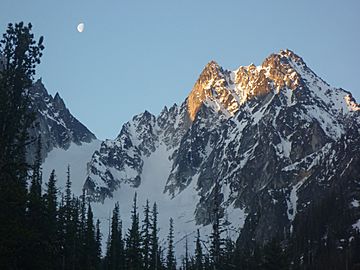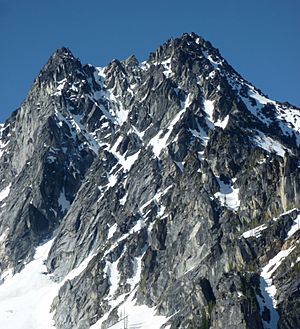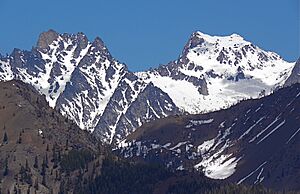Colchuck Peak facts for kids
Quick facts for kids Colchuck Peak |
|
|---|---|

Colchuck Peak from near Colchuck Lake
|
|
| Highest point | |
| Elevation | 8,705+ ft (2,650+ m) |
| Prominence | 665 ft (200 m) |
| Geography | |
| Parent range | Cascades |
| Topo map | USGS Enchantment Lakes |
| Geology | |
| Age of rock | Cretaceous |
| Type of rock | Granite |
| Climbing | |
| First ascent | 1948 Elvin and Norma Johnson, William and Kathy Long |
| Easiest route | Scrambling |
Colchuck Peak is a tall mountain in Washington state. It stands at about 8,705 feet (2,653 meters) high. You can find it in the Stuart Range, which is part of the Alpine Lakes Wilderness in Chelan County.
This peak is close to other famous mountains. Dragontail Peak is just a short distance to the east. Argonaut Peak is also nearby, to the southwest. Colchuck Peak has a glacier on its northeast side called the Colchuck Glacier. This glacier melts into Colchuck Lake. The mountain and glacier get their name from this lake. In Chinook Jargon, a language once used by Native Americans, "Colchuck" means "cold water." Water from the peak flows into different creeks, eventually reaching the Wenatchee River.
Weather at Colchuck Peak
The weather around Colchuck Peak is mostly shaped by the Pacific Ocean. Big weather systems, called weather fronts, usually start over the ocean. They then travel east towards the Cascade Mountains.
When these weather fronts hit the tall Cascade Mountains, they are forced to rise. As the air goes higher, it cools down. This causes the moisture in the air to turn into rain or snow. This process is called Orographic lift. Because of this, the Cascade Mountains get a lot of rain and snow, especially in winter.
During winter, it's often cloudy. But in summer, high-pressure systems over the Pacific Ocean usually bring clear skies. This means you can often enjoy sunny weather in the mountains during the warmer months.
How Colchuck Peak Was Formed
The Alpine Lakes Wilderness is known for its amazing landscape. It has jagged peaks, sharp ridges, and deep valleys carved by glaciers. You'll also see huge granite walls and more than 700 mountain lakes. All these features were created by powerful geological events over millions of years. These events led to the big changes in elevation and different climates you see today.
The story of the Cascade Mountains began millions of years ago, during the late Eocene Epoch. At that time, the North American Plate was slowly moving over the Pacific Plate. This movement caused a lot of volcanic activity. Also, small pieces of the Earth's crust, called terranes, joined together to form the North Cascades about 50 million years ago.
Colchuck Peak is part of a huge area of solid granite rock called the Mount Stuart batholith. This batholith forms the entire Stuart Range.
About two million years ago, during the Pleistocene period, huge sheets of ice called glaciers moved across the land. These glaciers advanced and then melted back many times. As they moved, they scraped away rock and left behind debris. The last time glaciers melted in the Alpine Lakes area was about 14,000 years ago.
The "U"-shaped valleys you see in the mountains are a clear sign of this recent glaciation. The combination of land being pushed up (called uplift) and cracks forming in the Earth's crust (called faulting), along with the glaciers, created the tall peaks and deep valleys of the Alpine Lakes Wilderness.
More Information
- Colchuck Peak weather: Mountain Forecast





